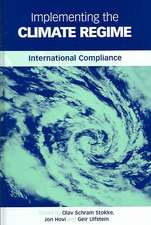The Constitution of the Environmental Emergency
Autor Jocelyn Staceyen Limba Engleză Hardback – 18 apr 2018
| Toate formatele și edițiile | Preț | Express |
|---|---|---|
| Paperback (1) | 271.76 lei 6-8 săpt. | |
| Bloomsbury Publishing – 19 aug 2020 | 271.76 lei 6-8 săpt. | |
| Hardback (1) | 541.20 lei 6-8 săpt. | |
| Bloomsbury Publishing – 18 apr 2018 | 541.20 lei 6-8 săpt. |
Preț: 541.20 lei
Preț vechi: 774.49 lei
-30% Nou
Puncte Express: 812
Preț estimativ în valută:
103.56€ • 108.40$ • 86.19£
103.56€ • 108.40$ • 86.19£
Carte tipărită la comandă
Livrare economică 31 martie-14 aprilie
Preluare comenzi: 021 569.72.76
Specificații
ISBN-13: 9781509920273
ISBN-10: 1509920277
Pagini: 296
Dimensiuni: 156 x 234 x 26 mm
Greutate: 0.59 kg
Editura: Bloomsbury Publishing
Colecția Hart Publishing
Locul publicării:London, United Kingdom
ISBN-10: 1509920277
Pagini: 296
Dimensiuni: 156 x 234 x 26 mm
Greutate: 0.59 kg
Editura: Bloomsbury Publishing
Colecția Hart Publishing
Locul publicării:London, United Kingdom
Caracteristici
This ambitious new work challenges long held approaches to the governance of the environment.
Notă biografică
Jocelyn Stacey is Assistant Professor at the Peter A. Allard School of Law at the University of British Columbia.
Cuprins
Introduction I. Methodology, Terminology and Context II. Outline of the Book Part I: The Environmental Emergency1. The Concept of the Environmental Emergency I. The Environmental Emergency II. Failing Schmitt's Challenge III. The Formal Conception of the Rule of Law IV. Conclusion 2. Environmental Reform: The Problem of Discretion in Environmental Law I. The Environmental Reform Position II. Black and Grey Holes in Canadian Environmental Law III. Impoverished Environmental Reform Solutions IV. Conclusion 3. Environmental Governance: The Problem of Law in Environmental Law I. Old and New Governance II. Three Examples of Environmental Governance III. Reclaiming the Rule of Law IV. Conclusion Part II: Responding to the Environmental Emergency 4. The Requirement of Public JustificationI. Responding to Schmitt's Challenge II. Public Justification: A Democratic Conception of the Rule of Law III. Conclusion 5. Institutional Design: Reforming Forest Practices I. The Institutional Dimensions of Public Justification II. The Forest Practices Board and the Mountain Pine Beetle Response III. The Forest Practices Board and Its Governance Response IV. Conclusion 6. Pipelines and Principles: Reasonableness and Fairness in Environmental Law I. The Pipelines, the NEB and Their Problems II. In Defence of Environmental Principles III. Publicly Justifying the Pipelines 7IV. Conclusion 7. Reasoning Adequately: Wind Turbine Risks and Benefits I. The Confluence of Environmental Factors in Wind Turbine Development II. The Method and Purpose of Reasonableness III. Reasoning Adequately about Wind Turbine Approvals IV. Conclusion 8. The Rule of Law and the Right to a Healthy Environment I. The Case for a Charter Right to a Healthy Environment II. Environmental Protection and Section 7 Adjudication III. Common Law Constitutional Rights Adjudication IV. Conclusion
Recenzii
With well-developed arguments supplemented by cases and legislation, this book provides refreshing perspectives on how governments should respond to environmental harm in a world where the survival of humankind seems to be overshadowed by rapid environmental degradation. It also makes a valuable contribution to constitutional law scholarship with its refreshing perspectives on the meaning of the rule of law and its implications.
Stacey's book presents a detailed and compelling case for reconceptualizing environmental law . the risk Stacey has taken in putting forward a novel thesis should pay off by challenging conventional thought among environmental and administrative law scholars.
Stacey's book presents a detailed and compelling case for reconceptualizing environmental law . the risk Stacey has taken in putting forward a novel thesis should pay off by challenging conventional thought among environmental and administrative law scholars.


















